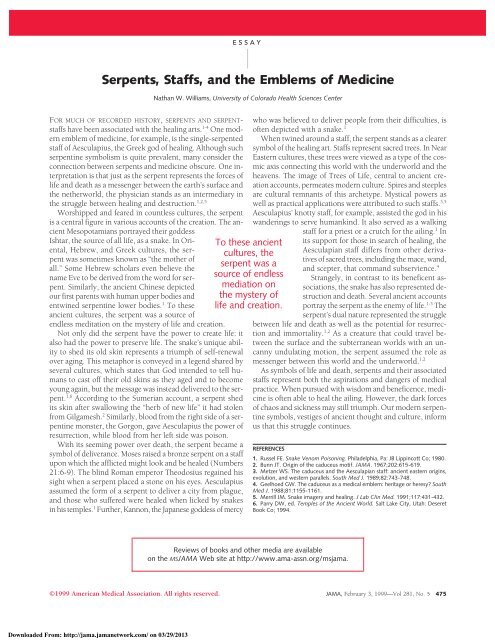JMS0203
JMS0203
JMS0203
You also want an ePaper? Increase the reach of your titles
YUMPU automatically turns print PDFs into web optimized ePapers that Google loves.
ESSAY<br />
Serpents, Staffs, and the Emblems of Medicine<br />
FOR MUCH OF RECORDED HISTORY, SERPENTS AND SERPENTstaffs<br />
have been associated with the healing arts. 1-4 One modern<br />
emblem of medicine, for example, is the single-serpented<br />
staff of Aesculapius, the Greek god of healing. Although such<br />
serpentine symbolism is quite prevalent, many consider the<br />
connection between serpents and medicine obscure. One interpretation<br />
is that just as the serpent represents the forces of<br />
life and death as a messenger between the earth’s surface and<br />
the netherworld, the physician stands as an intermediary in<br />
the struggle between healing and destruction. 1,2,5<br />
Worshipped and feared in countless cultures, the serpent<br />
is a central figure in various accounts of the creation. The ancient<br />
Mesopotamians portrayed their goddess<br />
Ishtar, the source of all life, as a snake. In Oriental,<br />
Hebrew, and Greek cultures, the serpent<br />
was sometimes known as “the mother of<br />
all.” Some Hebrew scholars even believe the<br />
name Eve to be derived from the word for serpent.<br />
Similarly, the ancient Chinese depicted<br />
our first parents with human upper bodies and<br />
entwined serpentine lower bodies. 1 To these<br />
ancient cultures, the serpent was a source of<br />
endless meditation on the mystery of life and creation.<br />
Not only did the serpent have the power to create life: it<br />
also had the power to preserve life. The snake’s unique ability<br />
to shed its old skin represents a triumph of self-renewal<br />
over aging. This metaphor is conveyed in a legend shared by<br />
several cultures, which states that God intended to tell humans<br />
to cast off their old skins as they aged and to become<br />
young again, but the message was instead delivered to the serpent.<br />
1,6 According to the Sumerian account, a serpent shed<br />
its skin after swallowing the “herb of new life” it had stolen<br />
from Gilgamesh. 2 Similarly, blood from the right side of a serpentine<br />
monster, the Gorgon, gave Aesculapius the power of<br />
resurrection, while blood from her left side was poison.<br />
With its seeming power over death, the serpent became a<br />
symbol of deliverance. Moses raised a bronze serpent on a staff<br />
upon which the afflicted might look and be healed (Numbers<br />
21:6-9). The blind Roman emperor Theodosius regained his<br />
sight when a serpent placed a stone on his eyes. Aesculapius<br />
assumed the form of a serpent to deliver a city from plague,<br />
and those who suffered were healed when licked by snakes<br />
in his temples. 1 Further, Kannon, the Japanese goddess of mercy<br />
Nathan W. Williams, University of Colorado Health Sciences Center<br />
To these ancient<br />
cultures, the<br />
serpent was a<br />
source of endless<br />
mediation on<br />
the mystery of<br />
life and creation.<br />
who was believed to deliver people from their difficulties, is<br />
often depicted with a snake. 1<br />
When twined around a staff, the serpent stands as a clearer<br />
symbol of the healing art. Staffs represent sacred trees. In Near<br />
Eastern cultures, these trees were viewed as a type of the cosmic<br />
axis connecting this world with the underworld and the<br />
heavens. The image of Trees of Life, central to ancient creation<br />
accounts, permeates modern culture. Spires and steeples<br />
are cultural remnants of this archetype. Mystical powers as<br />
well as practical applications were attributed to such staffs. 3,5<br />
Aesculapius’ knotty staff, for example, assisted the god in his<br />
wanderings to serve humankind. It also served as a walking<br />
staff for a priest or a crutch for the ailing. 1 In<br />
its support for those in search of healing, the<br />
Aesculapian staff differs from other derivatives<br />
of sacred trees, including the mace, wand,<br />
and scepter, that command subservience. 4<br />
Strangely, in contrast to its beneficent associations,<br />
the snake has also represented destruction<br />
and death. Several ancient accounts<br />
portray the serpent as the enemy of life. 1-3 The<br />
serpent’s dual nature represented the struggle<br />
between life and death as well as the potential for resurrection<br />
and immortality. 1,2 As a creature that could travel between<br />
the surface and the subterranean worlds with an uncanny<br />
undulating motion, the serpent assumed the role as<br />
messenger between this world and the underworld. 1,2<br />
As symbols of life and death, serpents and their associated<br />
staffs represent both the aspirations and dangers of medical<br />
practice. When pursued with wisdom and beneficence, medicine<br />
is often able to heal the ailing. However, the dark forces<br />
of chaos and sickness may still triumph. Our modern serpentine<br />
symbols, vestiges of ancient thought and culture, inform<br />
us that this struggle continues.<br />
REFERENCES<br />
1. Russel FE. Snake Venom Poisoning. Philadelphia, Pa: JB Lippincott Co; 1980.<br />
2. Bunn JT. Origin of the caduceus motif. JAMA. 1967;202:615-619.<br />
3. Metzer WS. The caduceus and the Aesculapian staff: ancient eastern origins,<br />
evolution, and western parallels. South Med J. 1989;82:743-748.<br />
4. Geelhoed GW. The caduceus as a medical emblem: heritage or heresy? South<br />
Med J. 1988;81:1155-1161.<br />
5. Merrill JM. Snake imagery and healing. J Lab Clin Med. 1991;117:431-432.<br />
6. Parry DW, ed. Temples of the Ancient World. Salt Lake City, Utah: Deseret<br />
Book Co; 1994.<br />
Reviews of books and other media are available<br />
on the MSJAMA Web site at http://www.ama-assn.org/msjama.<br />
©1999 American Medical Association. All rights reserved. JAMA, February 3, 1999—Vol 281, No. 5 475<br />
Downloaded From: http://jama.jamanetwork.com/ on 03/29/2013



